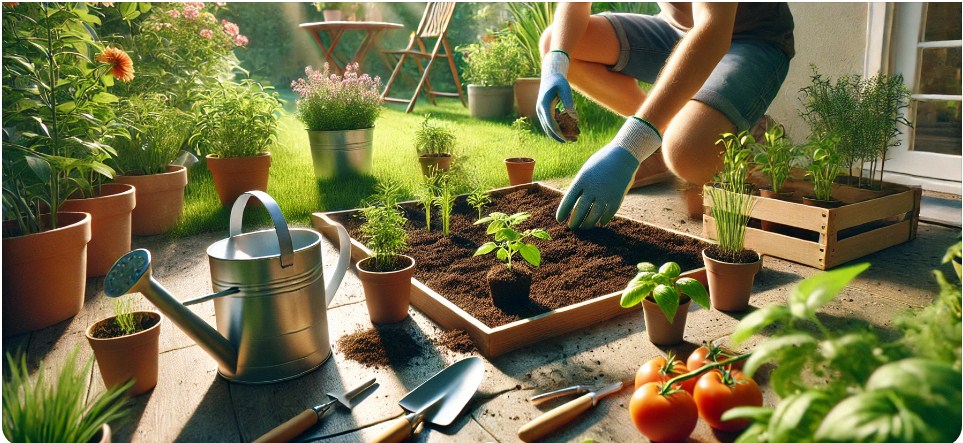Starting a home garden can be one of the most fulfilling hobbies you ever take up. Whether you’re looking to grow your own vegetables, nurture beautiful flowers, or simply create a green space for relaxation, gardening is good for your mind, your health, and your home. The best part? You don’t need a huge backyard or years of experience to get started. With a little planning and patience, anyone can build a thriving garden—even beginners.
In this step-by-step guide, you’ll learn exactly how to start your first garden at home, from choosing the right spot to maintaining your plants with confidence.
Step 1: Define Your Garden’s Purpose
Before you buy any plants or dig into the soil, take a moment to define what you want from your garden. Ask yourself:
-
Do I want to grow vegetables or herbs for cooking?
-
Am I more interested in flowers for decoration?
-
Do I want a low-maintenance green space?
-
How much time can I realistically dedicate each week?
Your goals will guide every decision you make going forward, from the types of plants you choose to how you organize your space.
Step 2: Choose the Right Location
Most plants need at least 6 hours of sunlight each day. Observe your available spaces (balcony, yard, window sill, etc.) throughout the day to see which areas receive the most natural light.
Also, consider:
-
Accessibility: You’ll want easy access for watering and maintenance.
-
Protection: Some spots might need shelter from strong winds or harsh afternoon sun.
-
Drainage: Avoid areas where water tends to pool after rain.
If you’re gardening indoors, choose sunny windows and consider using grow lights if natural light is limited.
Step 3: Decide Between Containers or Ground Planting
If you don’t have much outdoor space, don’t worry—container gardening is a great option. You can use pots, raised beds, or even recycled containers like buckets and crates.
Benefits of container gardening:
-
Ideal for small spaces
-
Easier to control soil and water conditions
-
Portable—you can move your plants as needed
If you have a yard or garden bed, ground planting is great for growing larger quantities and gives roots more room to spread. Just be sure to prep the soil properly.
Step 4: Choose Beginner-Friendly Plants
Start with plants that are easy to grow and resilient. Some great beginner options include:
Vegetables & Herbs:
-
Lettuce
-
Spinach
-
Radishes
-
Cherry tomatoes
-
Basil
-
Mint
-
Chives
Flowers:
-
Marigolds
-
Zinnias
-
Petunias
-
Sunflowers
Stick to plants that thrive in your climate, and always check the plant tags or seed packets for sunlight, spacing, and watering requirements.
Step 5: Prepare the Soil
Healthy soil is the foundation of any successful garden. Whether in containers or in-ground, good soil should be:
-
Well-draining (not too compacted or sandy)
-
Nutrient-rich (add compost or organic matter)
-
Neutral to slightly acidic pH
You can buy potting mix for containers or enrich your garden bed soil by mixing in compost, peat moss, or aged manure.
Tip: You can test your soil with affordable kits from garden centers or online stores.
Step 6: Plant with Care
Follow these basic planting guidelines:
-
Spacing: Don’t overcrowd your plants—give them space to grow and breathe.
-
Depth: Sow seeds or transplants at the depth recommended on the label.
-
Watering: Water deeply after planting to help roots settle.
Label your plants if you’re growing from seed—trust me, it gets hard to remember what’s what after a few weeks!
Step 7: Establish a Watering Routine
Watering needs vary depending on the plant and your climate, but here are some general rules:
-
Water early in the morning or late in the afternoon
-
Avoid wetting the leaves—water at the base
-
Stick your finger into the soil to check if it’s dry before watering again
Container gardens tend to dry out faster, so monitor them more closely.
Step 8: Mulch and Feed Your Plants
Adding mulch around your plants offers many benefits:
-
Helps soil retain moisture
-
Suppresses weed growth
-
Regulates temperature
-
Adds nutrients as it breaks down
Use straw, bark chips, shredded leaves, or even grass clippings.
You can also use organic fertilizers like compost tea, fish emulsion, or slow-release pellets depending on the needs of your plants.
Step 9: Monitor for Pests and Problems
Even beginner gardens can attract pests, but you can handle most of them without chemicals. Here’s how:
-
Check your plants regularly for holes, discoloration, or insects
-
Remove visible pests by hand or spray with a mix of water and mild soap
-
Encourage natural predators like ladybugs and birds
Avoid overreacting to every small issue—plants are tougher than we think!
Step 10: Be Consistent and Have Patience
Gardening is a long-term relationship with your plants. The key is consistency:
-
Water and feed regularly
-
Weed often
-
Keep a gardening journal or photo log to track growth and success
And most importantly: enjoy the process. You’ll learn more from each season, and every new sprout is a tiny victory.
Celebrate Your First Harvest!
The first time you harvest herbs for your pasta, see a flower bloom, or bite into a homegrown tomato—it’s magical. Starting a garden is more than just a hobby; it’s an act of care, patience, and connection with nature.
So roll up your sleeves, dig into the soil, and let your gardening journey begin.
